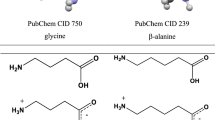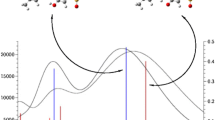Abstract
Background
The influence of hybrid solvation models on the molecular structures and vibrational characteristics of g−aminobutyric acid (GABA) and a−aminoisobutyric acid (AIB) zwitterions was assessed by employing a variety of Density Functional Theory (DFT). The quantum chemical methods included the B3LYP and B3PW91 hybrid functionals and the 6‑311++G(d,p) basis set.
Methods
The most stable conformation derived from the potential energy surface (PES) scans using the B3LYP/6-311++G(d,p) model chemistry for each studied molecule was predicted within a continuum environment represented by the COSMO and SMD solvation models. The stable structures were subsequently immersed in explicit/COSMO and explicit/SMD hybrid solvation models, where 10 and 8 water molecules were explicitly positioned around the functional groups of the GABA and AIB zwitterions, respectively. The number of water molecules chosen was sufficient to prevent proton transfer among the carboxylate group (COO−) and the ammonium group (NH3+) within each molecule under investigation. After optimizing the geometry of each hydrated complex, the normal vibrational modes were determined. The scaled theoretical frequencies obtained from the various model chemistries were then compared to available experimental data from infrared (IR) and Raman spectroscopy.
Results
In the case of GABA and AIB molecules, the comparisons revealed that the B3LYP/6-311++G(d,p) model chemistry yielded wavenumber values that closely matched the experimental IR and Raman data, particularly when the explicit/SMD solvent was employed. The computed results indicate deviations of less than 4% when compared to the experimental data for the two molecules under investigation.



Similar content being viewed by others
Data availability
The data presented in this study are available upon request from the corresponding authors.
References
Ding Y, Ting JP, Liu J et al (2020) Impact of non-proteinogenic amino acids in the discovery and development of peptide therapeutics. Amino Acids 52:1207–1226. https://doi.org/10.1007/s00726-020-02890-9
Goettig P, Koch NG, Budisa N (2023) Non-canonical amino acids in analyses of protease structure and function. Int J Mol Sci 24:14035. https://doi.org/10.3390/ijms241814035
Sarasa SB, Mahendran R, Muthusamy G et al (2020) A brief review on the non-protein amino acid, gamma-amino butyric acid (gaba): its production and role in microbes. Curr Microbiol 77:534–544. https://doi.org/10.1007/s00284-019-01839-w
Al-Wadei HAN, Ullah MF, Al-Wadei M (2011) GABA (γ-aminobutyric acid), a non-protein amino acid counters the β-adrenergic cascade-activated oncogenic signaling in pancreatic cancer: A review of experimental evidence. Mol Nutr Food Res 55:1745–1758. https://doi.org/10.1002/mnfr.201100229
Alonso JL, Peña I, López JC et al (2019) The shape of the simplest non-proteinogenic Amino Acid α-Aminoisobutyric Acid (Aib). Chem – A Eur J 25:2288–2294. https://doi.org/10.1002/chem.201805038
Kinnersley AM, Turano FJ (2000) Gamma aminobutyric acid (GABA) and plant responses to stress. CRC Crit Rev Plant Sci 19:479–509. https://doi.org/10.1080/07352680091139277
Dhakal R, Bajpai VK, Baek K-H (2012) Production of gaba (γ - aminobutyric acid) by microorganisms: a review. Brazilian J Microbiol 43:1230–1241. https://doi.org/10.1590/S1517-83822012000400001
Brosnan JT, Brosnan ME (2013) Glutamate: a truly functional amino acid. Amino Acids 45:413–418. https://doi.org/10.1007/s00726-012-1280-4
Tsuji G, Misawa T, Doi M, Demizu Y (2018) Extent of helical induction caused by introducing α-aminoisobutyric acid into an oligovaline sequence. ACS Omega 3:6395–6399. https://doi.org/10.1021/acsomega.8b01030
Dou Z, Li M, Shen Z et al (2023) GAD1-mediated GABA elicits aggressive characteristics of human oral cancer cells. Biochem Biophys Res Commun 681:80–89. https://doi.org/10.1016/j.bbrc.2023.09.041
Bowery NG, Smart TG (2006) GABA and glycine as neurotransmitters: a brief history. Br J Pharmacol 147:. https://doi.org/10.1038/sj.bjp.0706443
Crittenden DL, Chebib M, Jordan MJT (2005) Stabilization of zwitterions in solution: GABA analogues. J Phys Chem A 109:4195–4201. https://doi.org/10.1021/jp050320a
Sharma B, Chandra A (2018) On the issue of closed versus open forms of gamma-aminobutyric acid (GABA) in water: Ab initio molecular dynamics and metadynamics studies. J Chem Phys 148:. https://doi.org/10.1063/1.5021702
Harris H (1952) Family studies on the urinary excretion of ß-aminoisobutyric acid. Ann Eugen 17:43–49. https://doi.org/10.1111/j.1469-1809.1952.tb02496.x
Crumpler HR, Dent CE, Harris H, Westall RG (1951) β-Aminoisobutyric Acid (α-Methyl-β-Alanine): A New Amino-Acid Obtained from Human Urine. Nature 167:307–308. https://doi.org/10.1038/167307a0
Landi N, Ragucci S, Di Maro A (2021) Amino acid composition of milk from cow, sheep and goat raised in ailano and valle agricola, two localities of ‘alto casertano’ (campania region). Foods 10:2431. https://doi.org/10.3390/foods10102431
Purvis GD, King JW (1988) Proton transfer and triol formation in the simulation ofGABA solvation. Int J Quantum Chem 34:593–600. https://doi.org/10.1002/qua.560340863
Suresh DM, Sajan D, Laladas KP et al (2008) Vibrational Spectra of γ-Aminobutyric Acid. In: AIP Conference Proceedings. AIP, pp 95–97
Koyambo-Konzapa S-J, Premkumar R, Berthelot Saïd Duvalier RV et al (2022) Electronic, spectroscopic, molecular docking and molecular dynamics studies of neutral and zwitterionic forms of 3, 4-dihydroxy-l-phenylalanine: A novel lung cancer drug. J Mol Struct 1260:132844. https://doi.org/10.1016/j.molstruc.2022.132844
Minguirbara A, Vamhindi BSDR, Koyambo-Konzapa SJ, Nsangou M (2020) Effects of counterions and solvents on the geometrical and vibrational features of dinucleoside-monophosphate (dNMP): case of 3’,5’-dideoxycytidine-monophosphate (dDCMP). J Mol Model 26:. https://doi.org/10.1007/s00894-020-04369-6
Koyambo-Konzapa S-J, Dhaouadi Z, Nsangou M (2019) Hydration of l-glycylvaline and l-glycylvalylglycine zwitterions: Structural and vibrational studies using DFT method. J Mol Graph Model 88:194–202. https://doi.org/10.1016/j.jmgm.2019.01.012
Koyambo-Konzapa SJ, Minguirbara A, Nsangou M (2015) Solvent effects on the structures and vibrational features of zwitterionic dipeptides: L-diglycine and L-dialanine. J Mol Model 21:. https://doi.org/10.1007/s00894-015-2718-x
Daver H, Algarra AG, Rebek J et al (2018) Mixed explicit-implicit solvation approach for modeling of alkane complexation in water-soluble self-assembled capsules. J Am Chem Soc 140:12527–12537. https://doi.org/10.1021/jacs.8b06984
Raucci U, Perrella F, Donati G et al (2020) Ab-initio molecular dynamics and hybrid explicit-implicit solvation model for aqueous and nonaqueous solvents: <scp>GFP</scp> chromophore in water and methanol solution as case study. J Comput Chem 41:2228–2239. https://doi.org/10.1002/jcc.26384
Kamerlin SCL, Haranczyk M, Warshel A (2009) Are Mixed Explicit/Implicit Solvation Models Reliable for Studying Phosphate Hydrolysis? A Comparative Study of Continuum, Explicit and Mixed Solvation Models. ChemPhysChem 10:1125–1134. https://doi.org/10.1002/cphc.200800753
Pallavi L, Tonannavar J, Tonannavar J (2020) DFT zwitterion model for vibrational and electronic structure of unnatural 3-amino-3-(4-fluorophenyl)propionic acid, aided by IR and Raman spectroscopy. J Mol Struct 1211:128085. https://doi.org/10.1016/j.molstruc.2020.128085
Prabhu MD, TonannavarYenagi J, Kamat V, Tonannavar J (2020) XRD structure and vibrational analysis of DL-β-Leucine, as aided by DFT tetramer model and characterized by NBO, AIM and NCI calculations. J Mol Struct 1218:128495. https://doi.org/10.1016/j.molstruc.2020.128495
Edwin B, Hubert Joe I (2013) Vibrational spectral analysis of anti-neurodegenerative drug Levodopa: A DFT study. J Mol Struct 1034:119–127. https://doi.org/10.1016/j.molstruc.2012.09.004
Yalagi S (2022) Study of vibrational spectra of zwitterionic 3-Aminobutanoic acid, as supported by DFT calculations. World J Adv Res Rev 16:1122–1131. https://doi.org/10.30574/wjarr.2022.16.3.1487
Marenich AV, Cramer CJ, Truhlar DG (2009) Universal solvation model based on solute electron density and on a continuum model of the solvent defined by the bulk dielectric constant and atomic surface tensions. J Phys Chem B 113:6378–6396. https://doi.org/10.1021/jp810292n
Miguel ELM, Santos CIL, Silva CM, Pliego JR Jr (2016) How accurate is the smd model for predicting free energy barriers for nucleophilic substitution reactions in polar protic and dipolar aprotic solvents? J Braz Chem Soc. https://doi.org/10.5935/0103-5053.20160095
Herbert JM (2021) Dielectric continuum methods for quantum chemistry. WIREs Comput Mol Sci 11:. https://doi.org/10.1002/wcms.1519
Guerard JJ, Arey JS (2013) Critical evaluation of implicit solvent models for predicting aqueous oxidation potentials of neutral organic compounds. J Chem Theory Comput 9:5046–5058. https://doi.org/10.1021/ct4004433
Boys SF, Bernardi F (1970) The calculation of small molecular interactions by the differences of separate total energies. Some procedures with reduced errors. Mol Phys 19:553–566. https://doi.org/10.1080/00268977000101561
Jensen F (2010) An atomic counterpoise method for estimating inter- and intramolecular basis set superposition errors. J Chem Theory Comput 6:100–106. https://doi.org/10.1021/ct900436f
Gaigeot M-P, Ghomi M (2001) Geometrical and vibrational properties of nucleic acid constituents interacting with explicit water molecules as analyzed by density functional theory calculations. 1. Uracil + n w H 2 O ( n w = 1,...,7). J Phys Chem B 105:5007–5017. https://doi.org/10.1021/jp0040401
Nagy PI, Erhardt PW (2006) Ab initio study of hydrogen-bond formation between cyclic ethers and selected amino acid side chains. J Phys Chem A 110:13923–13932. https://doi.org/10.1021/jp061113t
Hernández B, Pflüger F, Nsangou M, Ghomi M (2009) Vibrational analysis of amino acids and short peptides in hydrated media. iv. amino acids with hydrophobic side chains: <scp>l</scp> -alanine, <scp>l</scp> -Valine, and <scp>l</scp> -Isoleucine. J Phys Chem B 113:3169–3178. https://doi.org/10.1021/jp809204d
Nsangou M (2011) DFT study of geometrical and vibrational features of small amino acids with polar side chains in hydrated media: L-Threonine and L-Serine. Comput Theor Chem 966:364–374. https://doi.org/10.1016/j.comptc.2011.03.038
Hernández B, Pflüger F, Adenier A et al (2011) Energy maps, side chain conformational flexibility, and vibrational features of polar amino acids <scp>L</scp> -serine and <scp>L</scp> -threonine in aqueous environment. J Chem Phys 135:. https://doi.org/10.1063/1.3617415
Frisch MJ, Trucks GW, Schlegel HB et al (2010) Gaussian09 Revision D.01, Gaussian Inc. Wallingford CT. Gaussian 09 Revis. C.01
Dennington R, Keith T, Millam J (2009) GaussView, Version 5. Semichem Inc. , Shawnee Mission. KS
Acknowledgements
S-J K-K conveys appreciation to the Abdus Salam International Centre for Theoretical Physics (ICTP) in Trieste, Italy, for awarding a grant through the 2022 ASESMANET Intra-Africa mobility program, which supported a visit to the School of Physics and Earth Sciences at The Technical University of Kenya, Nairobi. The authors acknowledge the Centre for High Performance Computing (CHPC, Grant number MATS862), South Africa, for providing resources to this research project. We also thank Prof. Mahmoud Ghomi (Université Paris 13, France), for providing us with the homemade program BORNS-PC that was useful for the assignment of the vibrational modes.
Funding
The authors declare that no funds, grants, or other support were received during the preparation of this manuscript.
Author information
Authors and Affiliations
Contributions
The contributions of the authors are as follows:
Yves Dague: Conceptualization, Writing – original draft, Data curation, Investigation. Stève-Jonathan Koyambo-Konzapa: Conceptualization, Supervision, Investigation, Writing – review & editing. Nose Holliness: Methodology, software. Alain Minguirbara: Methodology, Resources. George Amolo: Validation, Resources. Mama Nsangou: Supervision, Projet administration, Validation.
Corresponding authors
Ethics declarations
Competing interests
The authors declare that they have no known competing financial interests or personal relationships that could have appeared to influence the work reported in this paper.
Additional information
Publisher's Note
Springer Nature remains neutral with regard to jurisdictional claims in published maps and institutional affiliations.
Supplementary Information
Below is the link to the electronic supplementary material.
Rights and permissions
Springer Nature or its licensor (e.g. a society or other partner) holds exclusive rights to this article under a publishing agreement with the author(s) or other rightsholder(s); author self-archiving of the accepted manuscript version of this article is solely governed by the terms of such publishing agreement and applicable law.
About this article
Cite this article
Dague, Y., Koyambo-Konzapa, SJ., Nose, H. et al. DFT investigation on the structural and vibrational behaviours of the non-protein amino acids in hybrid explicit/continuum solvent: a case of the zwitterions γ-aminobutyric and α − aminoisobutyric acids. J Mol Model 30, 17 (2024). https://doi.org/10.1007/s00894-023-05817-9
Received:
Accepted:
Published:
DOI: https://doi.org/10.1007/s00894-023-05817-9




